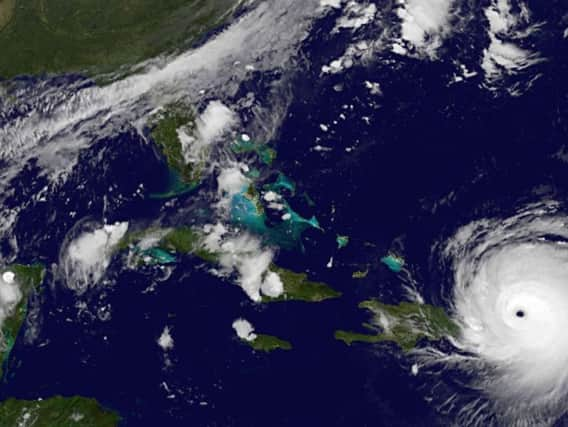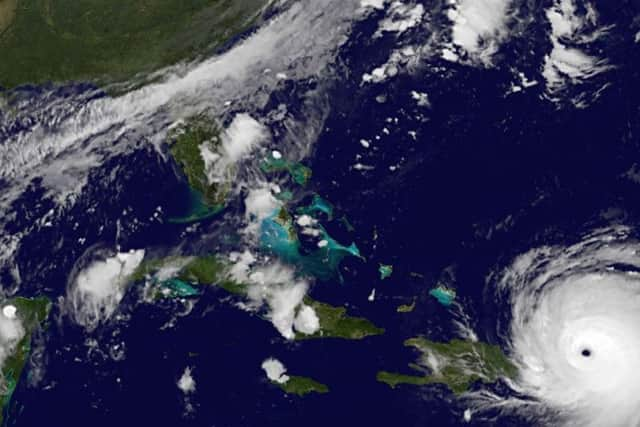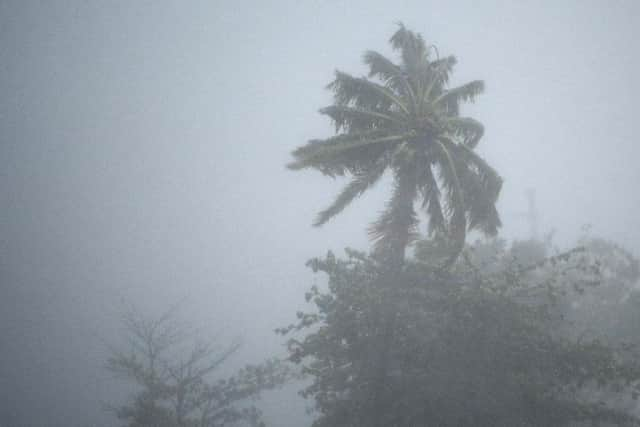Stunning satellite video shows huge scale of hurricane Irma as she leaves trail of destruction in Caribbean


The storm destroyed nearly all buildings on the island of Barbuda on Wednesday, killing a two-year-old child as a family tried to escape, before wreaking havoc on the French territories of St Martin and St Barts.
At least eight people were killed and 23 injured in French Caribbean island territories, while one death was reported in the nearby island of Anguilla, a British overseas territory that was among the first islands to be hit.
Advertisement
Hide AdAdvertisement
Hide AdOfficials reported extensive damage to its airport, hospitals, shelters and school and said 90% of roads are impassible, according to the Caribbean Disaster Emergency Management Agency, which also reported "major damage" to houses and commercial buildings in the British Virgin Islands.


Foreign Secretary Boris Johnson said the UK is "taking swift action to respond" to the disaster after speaking to the chief minister of Anguilla.
A meeting of the Government's emergency Cobra committee is being held to coordinate the response to Hurricane Irma after Prime Minister Theresa May discussed the situation with French president Emmanuel Macron by telephone.
Thomas Cook said they have sent 18 members of their special assistance team to Cuba and the Dominican Republic to help stranded holidaymakers.
Advertisement
Hide AdAdvertisement
Hide AdThey are evacuating customers in Cayo Coco, Cayo Guillermo and Cayo Santa Maria to Varadero in Cuba, part of which is still in the storm's projected path.


Thousands of British tourists are believed to be holidaying in the Caribbean, the travel association ABTA said.
Britons in the region have been urged to follow evacuation orders, while states of emergency have been declared in Puerto Rico, Cuba and Florida - amid fears Miami could be struck directly by the hurricane.
Sir Richard Branson, who refused to leave his private retreat in the British Virgin Islands, was counting the cost of widespread damage after the category five hurricane pounded the archipelago.
Advertisement
Hide AdAdvertisement
Hide AdThe British Government has made £12 million available immediately to help with the relief effort, while the Disasters Emergency Committee (DEC) said it was monitoring the storm's path and impact.


On Thursday morning local time, Irma's eye was about 95 miles north of Punta Canta on the eastern tip of the Dominican Republic, having passed Puerto Rico, where it left more than 900,000 people without power.
Irma is moving at around 16mph on a course forecast to take it toward Turks and Caicos and the south-eastern Bahamas by Thursday evening, and near the Central Bahamas by Friday.
An alert sent by the Department of Disaster Management and Emergencies on Grand Turk urged residents near the coasts to take shelter on higher ground, warning the storm surge could raise water levels by 15 to 20 feet above the normal tide.
Advertisement
Hide AdAdvertisement
Hide AdMaximum sustained winds have fallen slightly to 180 mph (285 km/h) with higher gusts, and the storm is forecast to remain a category 4 or 5 over the next few days.


It is only the second time anywhere in the world a storm has been recorded maintaining such windspeeds for more than 24 hours, after typhoon Haiyan in 2013, according to an expert at the University of Colorado.
Meanwhile, two separate hurricanes are adding to the region's stormy conditions. Hurricane Katia in the south-western gulf of Mexico has prompted a hurricane warning for the country's coast, while Jose "continues intensifying" over the central Atlantic as it follows in Irma's wake.
Fears second major storm could hamper aid efforts
Emergency attempts to reach Caribbean island communities devastated by Hurricane Irma could be affected by a second major storm threatening the region.
Advertisement
Hide AdAdvertisement
Hide AdAccording to the United Nations up to 37 million people could be affected by the historic hurricane that has left at least seven dead and thousands homeless.
Irma, a category five hurricane, is expected to have passed over the Caribbean by Friday, however Hurricane Jose is expected to follow a similar path when it arrives over the weekend.
The category one storm is currently building in intensity in the north Atlantic, around 900 miles east of the Lesser Antilles where the island of Barbuda saw catastrophic damage on Wednesday.
It is feared the storm may strengthen to a potentially devastating category three hurricane, which can bring winds of up to 129mph.
Advertisement
Hide AdAdvertisement
Hide AdMet Office meteorologist Greg Dewhurst said: "Jose is currently forecast to follow a similar track initially to Irma, moving westwards in the Atlantic and to the north and east of the Caribbean where the hurricane was on Wednesday.
"Jose's a couple of days away and the track may change, but it's forecast to come close to those islands over the weekend."
While Irma has followed a path expected to take it toward the US state of Florida, Jose is expected to swing back out into the Atlantic after grazing Puerto Rico on Saturday night.
Mr Dewhurst said: "Jose is currently a category one hurricane and it is expected to be a category three by Friday and drop back down to a category two by Saturday.
Advertisement
Hide AdAdvertisement
Hide Ad"It may not make landfall and its outer edge may only reach land. Either way there may be a risk of strong winds and rain for the north east of the Caribbean.
"Obviously Jose coming in could hamper the clearing-up process. It's one they will be keeping a very close eye on."
While the Caribbean faces the possibility of being affected by a second major hurricane, Mexico is braced for the arrival of Hurricane Katia.
The category one hurricane was headed for coast of Veracruz state where it expected to make landfall on Friday evening.